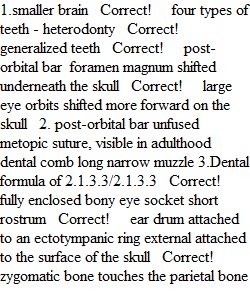


Q Question 1 0.8 / 0.8 pts Using the module image comparing the non-primate and the primate, check ALL traits that characterize the PRIMATE. There will be more than one correct answer - check all answers that apply. Some traits may also be true of the non-primate shown here, but can be useful as part of the cluster of traits that indicate a skull is from a primate. Question 2 0.8 / 0.8 pts Which of the following traits are true of Strepsirrhine primates? More than one answer is correct, check all that apply. Question 3 0.8 / 0.8 pts Platyrrhine skulls like this one are characterized by which traits? Check all answers that apply, there will be more than one correct answer. Question 4 0.8 / 0.8 pts Compare the catarrhine skull and the ape skull and select the traits that characterize the catarrhine monkey skull. There is more than one correct answer. Check all answers that apply. Catarrhine Monkey and Ape Skulls Catarrhine Ape - gibbon Catarrhine monkey- long-tailed macaque Photo Credit: Phil Myers, Museum of Zoology, University of Michigan - Ann Arbor. Accessed April 24, 2021. Animal Diversity Web Links to an external site.. Brown Capuchin Cebus apella. Photo Credit: Phil Myers, Museum of Zoology, University of Michigan - Ann Arbor. Accessed April 24, 2021. Animal Diversity Web Links to an external site.. Long-tailed Macaque Macaca fascicularis.
View Related Questions